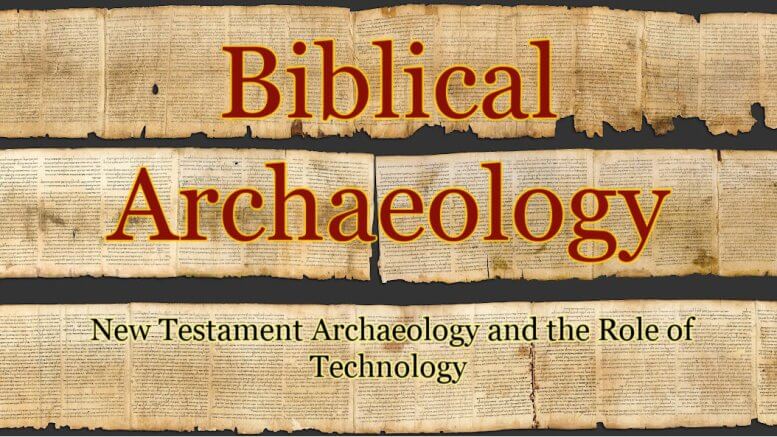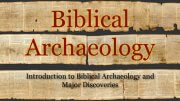Playback speed:
Introduction
In our previous posts, we introduced Biblical archaeology and explored significant Old Testament discoveries. We examined ancient writings and historical documents that support the Biblical narrative. Today, we focus on New Testament archaeology and technology’s role in uncovering the New Testament’s historical context. We will explore discoveries illuminating the life and times of Jesus and the early church, providing additional evidence of the Bible’s authenticity.
New Testament Archaeology
New Testament archaeology focuses on uncovering physical evidence related to events, people, and places described in the New Testament. These discoveries offer valuable insights into the historical and cultural context of the early Christian era.
Nazareth Inscription (Early 1st Century AD)
This marble tablet, discovered in Nazareth, contains an edict from an unnamed Roman emperor prohibiting the removal of bodies from tombs. Some scholars believe this edict responds to Jesus’s resurrection and suggests concern about grave robberies in the region where Jesus was buried.
The Pool of Bethesda (John 5:2)
Excavations in Jerusalem have revealed the remains of the Pool of Bethesda, described in the Gospel of John as the site where Jesus healed a paralytic man. The discovery of the pool and its five porticoes confirms the detailed description provided in the New Testament.
Peter’s House in Capernaum
Archaeologists have identified a house in Capernaum that many believe is the home of the Apostle Peter. This house, which later became a site of Christian worship, aligns with the New Testament accounts of Jesus’ activities in Capernaum (Matthew 8:14-16).
The Ossuary of James
This limestone burial box, inscribed with the words “James, son of Joseph, brother of Jesus,” has sparked significant debate. While some question its authenticity, many scholars believe it provides direct archaeological evidence of Jesus’ family.
The Role of Technology in Biblical Archaeology
Modern technology has revolutionized Biblical archaeology. It allows for more precise and noninvasive exploration methods, leading to discoveries and a deeper understanding of ancient sites.
Ground-penetrating radar (GPR)
GPR uses radar pulses to image the subsurface, enabling archaeologists to detect and map buried structures without excavation. This technology has been instrumental in identifying ancient buildings and tombs, including the potential location of David’s palace in Jerusalem.
3D Imaging and Reconstruction
3D imaging technology allows for the digital reconstruction of ancient sites and artifacts. This technique provides detailed visualizations of archaeological finds, helping researchers and the public better understand their original appearance and context.
Satellite Imaging
Satellite imagery identifies potential archaeological sites from space. This technology has been particularly useful in difficult-to-access regions, such as remote areas of the Sinai Peninsula and the Arabian Desert, where possible evidence of the Exodus route has been explored.
Carbon-14 Dating
Radiocarbon dating remains crucial for determining the age of organic materials found at archaeological sites. This method has been used to date artifacts and remains from the New Testament period, providing a chronological framework for historical events.
AI in Archaeological Analysis
Artificial Intelligence (AI) plays a transformative role in archaeology by enhancing the precision and scope of research. AI algorithms can analyze vast datasets, such as satellite imagery and geospatial data, to predict the locations of undiscovered archaeological sites. For example, in a study of ancient Mesopotamian sites, AI successfully identified potential areas of interest with 80% accuracy, guiding researchers to new sites that might otherwise remain hidden. Furthermore, AI is instrumental in reconstructing fragmented artifacts, using machine learning to piece together ancient objects accurately. This innovative application of AI accelerates archaeological discoveries and deepens our understanding of past civilizations.
Conclusion
New Testament archaeology, aided by modern technology, continues to uncover compelling evidence that supports the Bible’s historical accuracy. Discoveries such as the Pool of Bethesda, Peter’s house, and the Nazareth Inscription provide tangible connections to the events and people described in the New Testament. Moreover, using advanced technologies like ground-penetrating radar, 3D imaging, satellite imaging, and carbon-14 dating enhances our ability to explore and understand these ancient sites.
In our next post, we will address the controversies and debates in Biblical archaeology. We will explore the challenges and differing interpretations within the field and discuss how faith and scholarly inquiry coexist in pursuing historical truth.
Further Reading:





